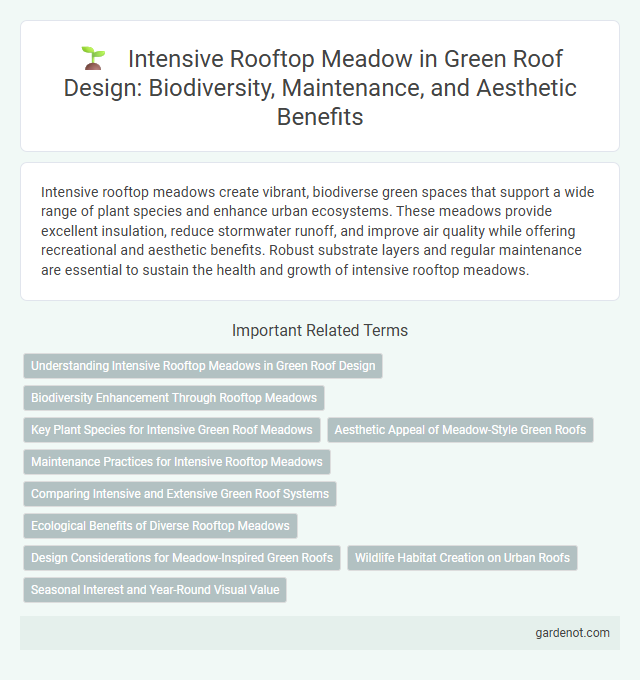Intensive rooftop meadows create vibrant, biodiverse green spaces that support a wide range of plant species and enhance urban ecosystems. These meadows provide excellent insulation, reduce stormwater runoff, and improve air quality while offering recreational and aesthetic benefits. Robust substrate layers and regular maintenance are essential to sustain the health and growth of intensive rooftop meadows.
Understanding Intensive Rooftop Meadows in Green Roof Design
Intensive rooftop meadows require a thicker substrate layer, typically over 6 inches, to support a diverse range of vegetation, including grasses, perennials, and even small shrubs. These green roofs demand more structural support due to their weight, necessitating thorough load-bearing assessments to ensure building safety. Proper irrigation and maintenance are critical to sustain the biodiversity and ecological benefits of intensive rooftop meadows in urban green roof design.
Biodiversity Enhancement Through Rooftop Meadows
Intensive rooftop meadows significantly boost urban biodiversity by providing diverse habitats for pollinators, birds, and beneficial insects, supporting ecological networks in city environments. These green roofs feature a variety of native plants and flowering species that attract and sustain wildlife, contributing to ecological resilience and species richness. Implementing rooftop meadows enhances green infrastructure by promoting ecosystem services such as air purification, temperature regulation, and stormwater management while fostering urban biodiversity.
Key Plant Species for Intensive Green Roof Meadows
Key plant species for intensive rooftop meadows include native grasses, wildflowers such as Echinacea purpurea, and sedum varieties like Sedum album, which enhance biodiversity and provide robust ground cover. Perennials like Festuca rubra and Achillea millefolium are favored for their drought tolerance and ability to thrive in shallow substrate depths. These species contribute to effective stormwater management, thermal insulation, and urban habitat expansion on intensive green roofs.
Aesthetic Appeal of Meadow-Style Green Roofs
Intensive rooftop meadows transform urban spaces with vibrant biodiversity and seasonal floral displays, significantly enhancing the aesthetic appeal of green roofs. These lush, meadow-style green roofs provide a dynamic landscape that changes throughout the year, attracting pollinators and creating a visual connection to nature. The multi-layered plant diversity contributes to a rich texture and color palette, making intensive green roofs a favorite choice for architects and city planners aiming to blend functionality with beauty.
Maintenance Practices for Intensive Rooftop Meadows
Intensive rooftop meadows require regular irrigation, fertilization, and pruning to maintain plant health and vigor, with monitoring schedules often ranging from weekly to monthly depending on local climate conditions. Soil health assessments and pest control measures are critical to prevent disease outbreaks and ensure sustainable growth, while seasonal adjustments in care optimize nutrient uptake and water retention. Employing these maintenance practices enhances biodiversity, extends the roof's lifespan, and maximizes the ecological benefits of the rooftop meadow.
Comparing Intensive and Extensive Green Roof Systems
Intensive rooftop meadows feature deeper soil layers, typically ranging from 6 to 24 inches, allowing for a greater diversity of plant species including shrubs and small trees, compared to extensive green roofs which have shallow substrates of 2 to 6 inches supporting mainly drought-tolerant sedums and grasses. The higher load capacity on intensive systems supports enhanced biodiversity and recreational use but demands increased structural support and maintenance costs. Extensive roofs prioritize lightweight, low-maintenance vegetation that aids in stormwater management and insulation, whereas intensive systems provide more ecological benefits and aesthetic versatility at higher price and labor investment.
Ecological Benefits of Diverse Rooftop Meadows
Intensive rooftop meadows with diverse plant species significantly enhance urban biodiversity by providing habitats for pollinators and birds. These green roofs improve air quality through increased carbon sequestration and help regulate microclimates, reducing the urban heat island effect. Their complex root systems also enhance stormwater management by retaining and filtering rainwater, decreasing runoff and protecting urban waterways.
Design Considerations for Meadow-Inspired Green Roofs
Intensive rooftop meadows require careful design considerations including soil depth of at least 6 to 12 inches to support diverse native grasses and wildflowers, ensuring adequate irrigation and drainage systems to maintain plant health and prevent waterlogging. Structural load capacity must accommodate the added weight of saturated soil and mature vegetation, typically around 80 to 150 pounds per square foot. Incorporating diversity in plant species enhances biodiversity and resilience, while drainage layers and root barriers protect the building envelope from moisture-related damage.
Wildlife Habitat Creation on Urban Roofs
Intensive rooftop meadows provide essential wildlife habitat creation on urban roofs by mimicking natural ecosystems with a diverse selection of native plants that attract pollinators, birds, and beneficial insects. These green roofs enhance urban biodiversity and promote ecological connectivity by offering food sources and nesting areas in densely built environments. Incorporating deep substrate layers allows for varied vegetation types, supporting complex habitats that contribute to urban wildlife conservation and environmental health.
Seasonal Interest and Year-Round Visual Value
Intensive rooftop meadows provide diverse seasonal interest through varied plant species that bloom in spring, summer, and autumn, ensuring continuous color and texture changes. These green roofs support year-round visual value by incorporating hardy perennials, ornamental grasses, and evergreen shrubs that maintain structure and vibrancy even in winter. The dynamic combination of flora enhances urban aesthetics while promoting biodiversity and environmental benefits throughout all seasons.
Intensive rooftop meadow Infographic

 gardenot.com
gardenot.com